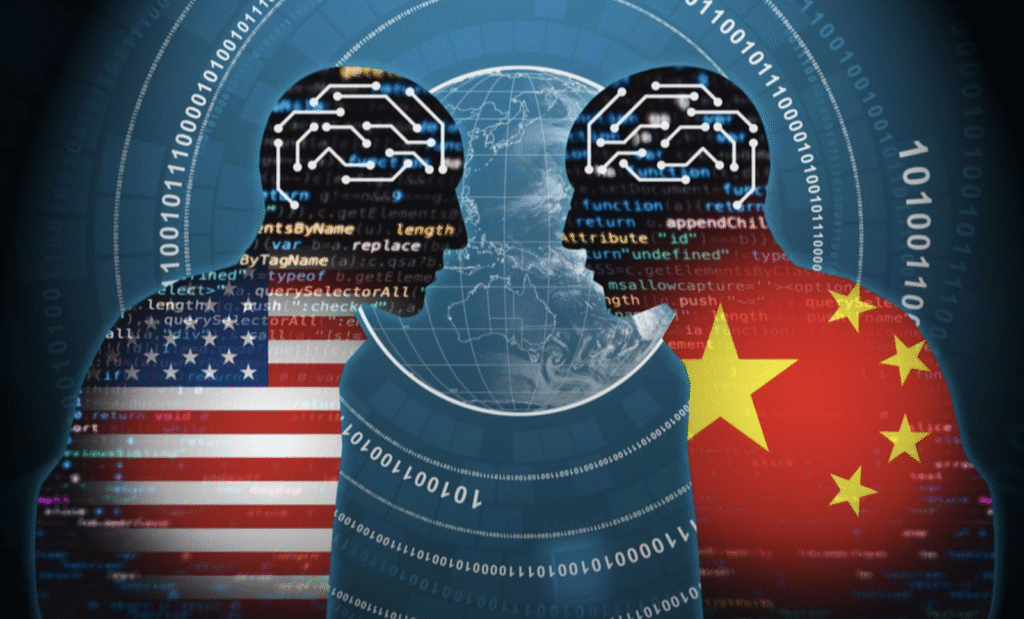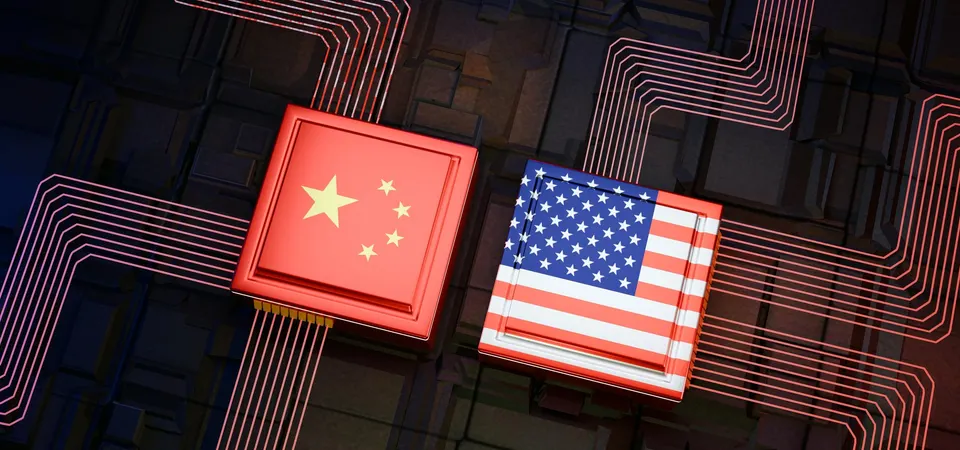Explore whether the U.S.–China tech rivalry has already decided the future of technological dominance. Detailed analysis of AI, semiconductors, 5G, supply chains, and what’s still at stake.
The trajectory of global technology dominance is increasingly shaped by the intensifying U.S.–China rivalry—especially across AI, semiconductors, and 5G. While both powers have unique advantages, the outcome remains undecided, hinging on innovation, alliances, and policy shifts.
Is the Future of Tech Already Decided?
In recent years, the competition between the United States and China has shifted from simple trade wars to what many experts now call a Tech Cold War. This battle is no longer about tariffs or supply chains—it’s about who will define the future of innovation, control the digital infrastructure, and lead the global economy in the next fifty years.
Every major field—Artificial Intelligence, quantum computing, semiconductors, 5G, 6G, robotics, and biotechnology—is now shaped by this rivalry.
But here’s the question many are asking:
Has the future of tech dominance already been decided by the U.S.–China rivalry?
The answer is complex. While China’s rise is undeniable, America’s deep ecosystem of innovation and alliances remains formidable. The global balance of power is not yet fixed, and what happens over the next decade will define the world’s technological architecture for generations.
This comprehensive article explores every layer of this issue—from hardware and AI to alliances, regulation, and real-world examples—to uncover whether the future is truly decided or still up for grabs.
1. Why Many Believe the Rivalry Has Already Decided the Future
Before challenging the idea that the outcome is sealed, let’s examine why so many analysts believe China’s technological dominance is inevitable. Several clear trends fuel that perception:
- Unprecedented Scale and Investment
China has poured hundreds of billions of dollars into R&D and infrastructure through initiatives like Made in China 2025 and China Standards 2035.
According to Visual Capitalist, Chinese R&D spending reached 2.4% of GDP, closing in on the U.S.’s 3.1%. - AI Momentum
Chinese companies like Baidu, Tencent, Alibaba, and startups like DeepSeek and Qwen are aggressively deploying AI models—especially in manufacturing, surveillance, and automation. - Supply Chain Control
China dominates rare earth exports and battery manufacturing, holding leverage over essential materials for chipmaking and green technologies. - Digital Decoupling
Western nations are de-risking, while China is building digital self-sufficiency. Huawei, SMIC, and ByteDance now operate independent of many Western components. - Sovereign Standards
China is actively promoting “Digital Silk Road” standards to developing nations, ensuring global adoption of Chinese technology frameworks.
In short, China’s state-backed approach gives it speed, coordination, and reach. However, momentum isn’t destiny—and the U.S. retains deep structural advantages.

2. The Major Battlegrounds of the Tech War
To understand who might dominate, we need to explore where the U.S.–China contest plays out most intensely.
1 Semiconductors: The Foundation of Modern Power
Semiconductors are the backbone of every modern technology—from smartphones to fighter jets.
Here’s how the competition unfolds:
- U.S. Strengths:
- Global leadership in chip design (NVIDIA, Intel, AMD, Qualcomm).
- Access to world-class EDA (Electronic Design Automation) software and tools.
- Dominance through allies—ASML (Netherlands), TSMC (Taiwan), and Samsung (Korea).
- China’s Challenges:
- Still struggling to produce chips under 7nm.
- Limited access to EUV lithography machines due to export restrictions.
- China’s Strategy:
- Massive state subsidies to SMIC and YMTC.
- Focus on “import substitution” and homegrown innovation.
- Control of gallium, germanium, and rare earth exports—critical for chip production.
Example: The U.S. CHIPS Act (2022) allocated $52 billion to rebuild domestic semiconductor manufacturing—an attempt to ensure America’s future resilience.
Takeaway:
China is catching up fast, but cutting-edge chipmaking still depends on Western technologies and alliances.
2 Artificial Intelligence: The New Frontier
AI defines the next era of national power. Both the U.S. and China view it as central to economic growth, national security, and global influence.
- U.S. Advantages:
- Access to large open datasets and high-end GPUs.
- A thriving ecosystem (OpenAI, Anthropic, Google DeepMind).
- Global AI talent concentration.
- China’s Edge:
- Massive deployment scale—AI in surveillance, logistics, fintech.
- Integration into public services and industrial automation.
- Looser data privacy laws for model training.
Example: Beijing’s “AI Governance Principles” aim to balance innovation and control—positioning China as both a developer and regulator of AI ethics.
Key Insight:
While China excels in application and deployment, the U.S. maintains a lead in foundational AI research, model architecture, and global developer adoption.
3 5G, 6G, and Digital Infrastructure
Connectivity is another battlefield.
- China’s 5G Dominance:
Huawei leads globally, having built networks in over 170 countries.
China has more than 2.8 million 5G base stations—by far the most worldwide. - U.S. Strategy:
The U.S. relies on private sector innovation (Qualcomm, Cisco) and alliances with Nokia and Ericsson to counter Huawei’s expansion. - 6G and the Next Race:
China aims for commercial 6G rollout by 2030, integrating AI-driven networking, satellite internet, and autonomous communication systems.
Takeaway:
Whoever dominates connectivity controls the data flow, the cloud edge, and the future digital economy.
4 Platforms, Cloud, and Software Ecosystems
Beyond hardware, platform ecosystems represent soft power.
- U.S. Firms:
Amazon Web Services (AWS), Google Cloud, Microsoft Azure, and Apple form the backbone of the world’s digital infrastructure. - China’s Platforms:
Alibaba Cloud and Huawei Cloud are expanding fast, especially across Asia and Africa.
TikTok’s success shows China’s ability to win in consumer-facing apps.
Example: TikTok’s global reach has triggered U.S. security debates—demonstrating how platform dominance translates to geopolitical influence.
Conclusion:
America remains the world’s software hub, but China’s closed digital ecosystems are reshaping global tech governance.
5 Alliances and Global Standards
No nation wins the tech war alone.
- The U.S. Model:
Multilateral cooperation with allies—Japan, South Korea, the EU, and India—under frameworks like the Quad and AUKUS.
The U.S. still dominates global IP and standards-setting organizations. - China’s Approach:
Promotes “Digital Silk Road” initiatives through Belt & Road partnerships.
Offers low-cost infrastructure and sovereign AI systems to developing nations.
Example: China’s 2023 AI Framework signed with over 40 African nations to co-develop digital governance rules.
Bottom Line:
Tech dominance now extends beyond innovation—it’s about who defines global rules.
6 Talent, Research, and Education
Talent is the most critical battleground.
- U.S. Leadership:
- Attracts global scientists and entrepreneurs.
- Hosts top-tier universities (MIT, Stanford, Caltech).
- Thrives on open academic exchange.
- China’s Strategy:
- “Thousand Talents Program” to repatriate scientists.
- Increased STEM enrollment and AI education.
- Massive patent and paper output growth (36% of global AI papers in 2025).
Challenge:
Decoupling policies and visa restrictions risk slowing U.S. talent inflow, while China’s state-driven research model faces creativity limits.
3. Structural Strengths and Vulnerabilities: A Side-by-Side View
| Category | U.S. Strengths | U.S. Weaknesses | China’s Strengths | China’s Weaknesses |
|---|---|---|---|---|
| Innovation | Entrepreneurial ecosystem, venture capital | Overregulation, funding gaps | Centralized coordination | Lack of open experimentation |
| R&D | Deep academic base | Talent restrictions | Massive funding scale | Limited fundamental science |
| Alliances | Global trust and soft power | Fragmentation | Expanding Belt & Road | Limited global trust |
| Supply Chain | Chip design, software | Material dependency | Manufacturing control | High-tech tool deficit |
| Talent | Global pull for experts | Political bottlenecks | Domestic scaling | Creative freedom limits |
Conclusion:
Both countries hold asymmetric advantages—the contest remains wide open.
4. Is the Outcome Predetermined or Still Open?
1 The Argument for “Predetermined”
- Scale Effects: China’s population and state-directed policy can amplify trends fast.
- Infrastructure Lock-in: Once countries adopt Chinese 5G or digital systems, switching becomes costly.
- Economic Leverage: Manufacturing integration and resource control extend geopolitical reach.
2 The Argument for “Still Open”
- Technological Wild Cards: Breakthroughs in quantum computing, bioengineering, or new chip architectures could reset competition.
- Alliances: The U.S. still leads a powerful coalition of democracies with advanced research capabilities.
- Open Ecosystems: Innovation thrives in open markets—an enduring U.S. advantage.
- Resilience: Democracies adapt through iteration and feedback; centralized models risk stagnation.
3 Future Scenarios
- Scenario A – The Dual Order:
Two tech ecosystems coexist—U.S.-led open systems vs China-led sovereign systems. - Scenario B – China’s Rise:
Beijing’s model becomes default across developing nations. - Scenario C – Hybrid Order:
Countries blend both models, creating a complex, interoperable landscape.
5. Trending FAQs on the U.S.–China Tech Rivalry
FAQ 1: Is China already ahead in Artificial Intelligence?
China has caught up in AI deployment and industrial application but still trails in foundational research.
While DeepSeek and Qwen showcase China’s progress, OpenAI, Anthropic, and Google DeepMind lead in core model innovation and scientific breakthroughs.
The race remains fluid—China is strong in application; the U.S. in innovation.
FAQ 2: Can the U.S. regain its dominance if lost?
Yes. Through:
- Strategic public-private partnerships
- Immigration and STEM reform
- Alliances with Europe, Japan, and India
- Large-scale R&D funding like the CHIPS and Science Act
America’s innovation culture remains its biggest asset.
FAQ 3: Are export bans truly effective against China?
Partially. Export bans slow China’s access to advanced chips but accelerate its domestic innovation drive.
China is already replicating legacy nodes and sourcing from non-U.S. suppliers.
In the long term, isolation may push China toward complete self-sufficiency.
FAQ 4: Could this tech war lead to real-world conflict?
While unlikely to escalate militarily, technology competition increases cyber risk, espionage, and supply chain weaponization.
Both nations are careful to avoid direct confrontation but continue competing fiercely in cyberspace and AI warfare.
FAQ 5: How will this rivalry impact U.S. consumers and businesses?
- Higher production costs due to supply chain reshoring.
- Restricted access to low-cost Chinese electronics.
- Dual standards in digital services.
- Opportunities in secure AI, chip manufacturing, and domestic tech investment.
FAQ 6: Is global tech fragmentation inevitable?
Yes, partial fragmentation is likely.
Expect a world with two digital ecosystems—one dominated by Western standards, another by Chinese infrastructure and governance models.
FAQ 7: What role do developing nations play in this rivalry?
Nations in Africa, Latin America, and Southeast Asia are key battlegrounds.
China’s affordable digital infrastructure offers quick development, while U.S. partnerships focus on trust and transparency.
These countries may ultimately determine global adoption trends.
FAQ 8: What are the biggest wild cards that could change everything?
- Quantum computing breakthroughs
- Semiconductor material innovation
- AI safety regulation alignment
- A new global digital treaty
FAQ 9: How should U.S. policymakers respond?
- Strengthen alliances
- Increase funding for critical R&D
- Reform talent visa policies
- Promote tech ethics and standards
A balanced approach—competitive yet cooperative—will serve long-term interests.
FAQ 10: How can businesses prepare for a fragmented tech world?
- Diversify suppliers and markets
- Ensure compliance with both U.S. and Chinese regulations
- Design interoperable systems
- Build internal AI and cybersecurity resilience
6. Key Takeaways and Strategic Advice
- Invest in core research – Quantum computing and bio-AI could redefine the future.
- Build alliances – Cooperation with EU, Japan, and India multiplies leverage.
- Diversify supply chains – Dependence on one region is a critical vulnerability.
- Adopt a dual-ecosystem strategy – Design for both Western and Eastern tech frameworks.
- Focus on talent – Human capital, not just capital investment, decides technological strength.
- Embrace open innovation – Transparency and adaptability are America’s enduring advantages.
7. Final Thoughts: The Future Is Not Yet Decided
The U.S.–China rivalry is not a passing trend—it’s the defining contest of the 21st century.
It determines not only who leads in technology, but also who sets the ethical, economic, and cultural foundations of the digital world.
While China’s pace and coordination impress, the U.S. still possesses deep innovation roots, alliances, and adaptability.
The future of tech dominance is not decided—it’s being written every day.
In this dynamic era, nations, companies, and individuals who stay informed, flexible, and forward-looking will thrive no matter which side wins.

